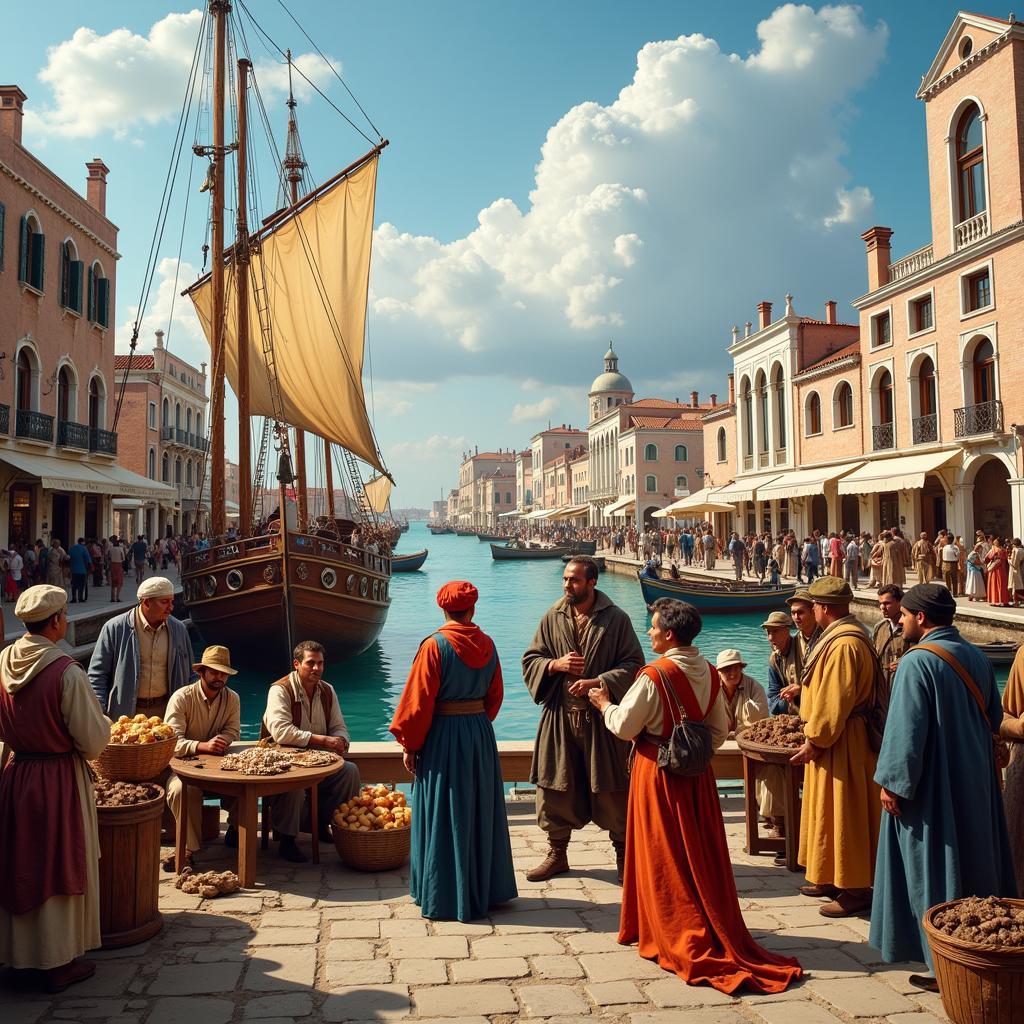The term “Venetian Society” often evokes images of masked balls, gondolas gliding through canals, and a sense of intrigue and mystery. While those images hold a certain allure, the reality of a “Venetian Society” can encompass a broader spectrum of meaning, depending on the context.
This article delves into the various interpretations of “Venetian Society,” exploring its historical significance, cultural connotations, and modern-day relevance.
A Glimpse into Venetian History and Society
The Venetian Republic, a maritime power that flourished for over a millennium, was renowned for its unique social structure and cultural vibrancy. The phrase “Venetian Society” often refers to the intricate web of social hierarchies, political systems, and artistic expressions that characterized this influential city-state.
 Venetian merchants engaging in trade
Venetian merchants engaging in trade
The Rise of a Maritime Powerhouse
Venice’s strategic location on the Adriatic Sea propelled its rise as a dominant force in maritime trade. The city’s merchants amassed immense wealth, influencing the social and political landscape. This mercantile elite, known as the “patrician” class, held significant power and shaped the city’s destiny.
A Complex Social Fabric
Venetian society was structured into distinct classes, each with its own privileges and limitations. While the patricians enjoyed considerable power, other groups, such as artisans, merchants, and laborers, contributed to the city’s dynamism.
Art and Culture as Pillars of Venetian Identity
Venice’s artistic and cultural achievements were unparalleled during the Renaissance. From the architectural marvels of Doge’s Palace to the masterpieces of Titian and Bellini, Venetian art reflected the city’s wealth, sophistication, and cosmopolitan outlook.
The Allure of Venetian Masks and Carnivals
No exploration of Venetian society would be complete without mentioning its iconic masks and elaborate carnivals. These elements, often shrouded in mystery and intrigue, continue to captivate the imagination.
The Significance of Venetian Masks
Venetian masks served a dual purpose: they concealed identities and blurred social boundaries. During carnival season, people from all walks of life could don masks, temporarily escaping the constraints of societal norms.
Carnivals: A Celebration of Excess and Freedom
Venetian carnivals were legendary for their extravagance and revelry. For weeks, the city transformed into a stage for masked balls, theatrical performances, and joyous celebrations. These events offered a temporary release from the rigid social structures of the time.
The Venetian Society: Enduring Legacy and Modern Interpretations
The Venetian Society, while rooted in history, continues to resonate in contemporary culture. Its legacy can be seen in various forms, from artistic representations to modern-day social clubs.
The concept of a “Venetian Society” has also been adopted by organizations and communities seeking to foster a sense of exclusivity, cultural appreciation, or social connection. For example, the Silversea Venetian Society caters to discerning travelers who share a passion for luxury cruising and exploring the world’s hidden gems.
Conclusion
The “Venetian Society” is a multifaceted concept that encompasses history, culture, and social dynamics. From the grandeur of its maritime empire to the allure of its masked balls, Venice continues to fascinate and inspire. Whether exploring its historical significance or its modern-day interpretations, the Venetian Society offers a glimpse into a world of beauty, intrigue, and enduring legacy.
FAQ
1. What was the social structure of Venetian society?
Venetian society was hierarchical, with the patrician class holding the most power. Other groups included merchants, artisans, and laborers, each contributing to the city’s economy and culture.
2. Why were Venetian masks so significant?
Venetian masks served to conceal identities and blur social boundaries, allowing people to interact more freely, especially during carnival season.
3. How long did the Venetian Republic last?
The Venetian Republic existed for over a millennium, from the late 7th century until the late 18th century.
4. What are some modern-day interpretations of the “Venetian Society”?
Modern interpretations include social clubs, organizations, and communities that adopt the name to evoke a sense of exclusivity, cultural appreciation, or shared interests.
5. What is the significance of Venice’s maritime history?
Venice’s location on the Adriatic Sea made it a major trading hub, contributing to its wealth, power, and cosmopolitan character.
Need Help?
For further assistance, please don’t hesitate to contact us:
Phone: 02043854663
Email: [email protected]
Address: Khu 34, Bắc Giang, 260000, Vietnam
Our dedicated customer support team is available 24/7 to assist you.